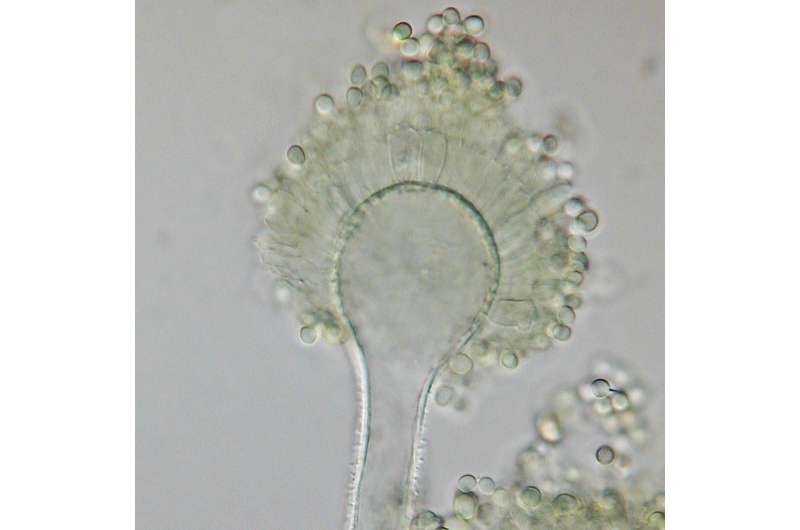December 20, 2017 report
Study suggests dangerous crop fungus produces toxic chemical to repel insects

A team of researchers from Cornell and North Carolina State University has conducted a study examining a possible connection between a toxin produced by a crop-damaging fungus and insects that may attempt to feed on it. In their paper published in Proceedings of the Royal Society B, the group describes their study and what they found.
Aspergillus flavus is a type of fungus that lives on plants, many of which are crops. Prior research has shown that many types of A. flavus also produce a toxin called aflatoxin that is harmful to crops such as corn, cereals, nuts and rice. Even worse is the impact the toxin has on animals and humans that consume it—doing so can cause stunted growth in children and liver cancer in adults. If consumed in high enough concentrations, it can kill directly. One of the ways that farmers try to combat the fungus is by spreading variants of A. flavus that do not produce the toxin, hoping it will crowd out the kind that does. In this new effort, the researchers believe they may have found a new approach—getting rid of the bugs that feed on the fungus.
Because just two-thirds of A. flavus produce the toxin, the researchers considered that there was likely something that caused them to produce the toxin—in its absence, they would not need it, so they would not produce it. The researchers guessed that the cause might be insects that either eat the fungus or compete with it for food. To find out if this might be the case, the group collected A. flavus samples and a group of fruit flies and brought them into their lab for study. They started out by noting that the fruit flies and fungus do eat the same foods and that the larvae sometimes actually ate the fungus. After running several experiments, the researchers found that the toxin produced by the fungus protected them from being eaten by the larvae. They also found that the types of fungus that produced the toxin grew more when the flies were present than when they were not. They found, too, that the fungus that made the toxin produced more of it when there were larvae in the vicinity.
Taken together, the researchers suggest, the evidence indicates that the reason the fungus makes the toxin is to defend itself from fruit flies—this finding suggests that a way to combat the fungus on the farm would be to combat the insects that are causing it to produce the toxin.
More information: Milton T. Drott et al. Balancing selection for aflatoxin in Aspergillus flavus is maintained through interference competition with, and fungivory by insects, Proceedings of the Royal Society B: Biological Sciences (2017). DOI: 10.1098/rspb.2017.2408
Abstract
The role of microbial secondary metabolites in the ecology of the organisms that produce them remains poorly understood. Variation in aflatoxin production by Aspergillus flavus is maintained by balancing selection, but the ecological function and impact on fungal fitness of this compound are unknown. We hypothesize that balancing selection for aflatoxin production in A. flavus is driven by interaction with insects. To test this, we competed naturally occurring aflatoxigenic and non-aflatoxigenic fungal isolates against Drosophila larvae on medium containing 0–1750 ppb aflatoxin, using quantitative PCR to quantify A. flavus DNA as a proxy for fungal fitness. The addition of aflatoxin across this range resulted in a 26-fold increase in fungal fitness. With no added toxin, aflatoxigenic isolates caused higher mortality of Drosophila larvae and had slightly higher fitness than non-aflatoxigenic isolates. Additionally, aflatoxin production increased an average of 1.5-fold in the presence of a single larva and nearly threefold when the fungus was mechanically damaged. We argue that the role of aflatoxin in protection from fungivory is inextricably linked to its role in interference competition. Our results, to our knowledge, provide the first clear evidence of a fitness advantage conferred to A. flavus by aflatoxin when interacting with insects.
Journal information: Proceedings of the Royal Society B
© 2017 Phys.org


















